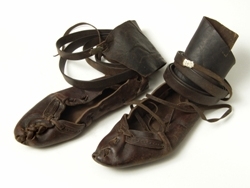Nora Čechmánková, Petra Jarošová
Krpce (also known as peasant’s shoes) are low, leather made from two rectangles of processed leather. To their archaic origins speak the simplicity and sophistication of design which was achieved with the perfect and complete use of available material. Krpce are not sown with thread, but with thin, small pieces of leather, leather yarn, which is taken directly from the rectangles which give rise to the shoe. Majority of the krpce are made in four simple steps: first the toe is sown by one piece of leather yarn, next the outside of the shoe is reinforced and molded by that same leather yarn. Third is the molding of the inside of the shoe with a new piece of leather yarn and lastly the heel is fashioned in a way that forms it by tightening with a long leather yarn.
The principle of footwear which is worn by strapping it around the foot by a piece of leather can be traced back to many cultures which depended on self-sustaining lifestyles.
During the times of growth in popularity of the peasant’s shoes, they were either produced by the father of the family, or by experienced members of the local community who looked for supplemental employment in addition to their domestic work. The most commonly used raw material in production of krpce was cowhide.
In Slovakia, this footwear was particularly widespread in the mountainous areas and their adjacent valleys. Krpce protected the foot, kept in the heat by insulation, and for sometime remained waterproof. Overall they stayed on the leg well, didn’t wear the foot out, and were at the same time light and could be worn in any season.
